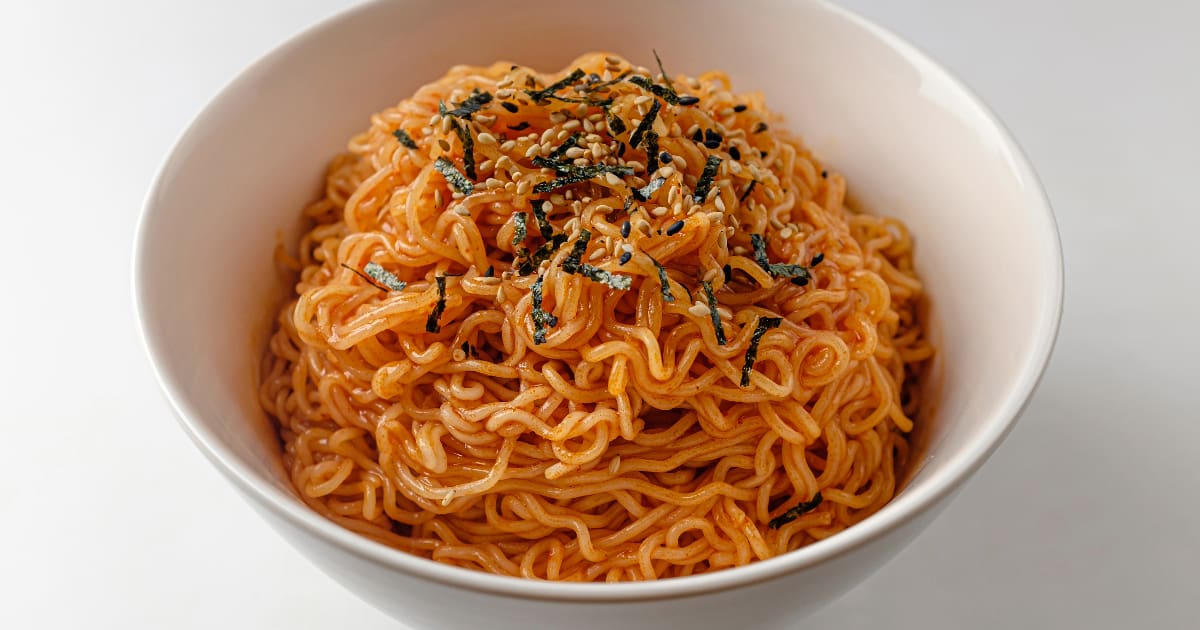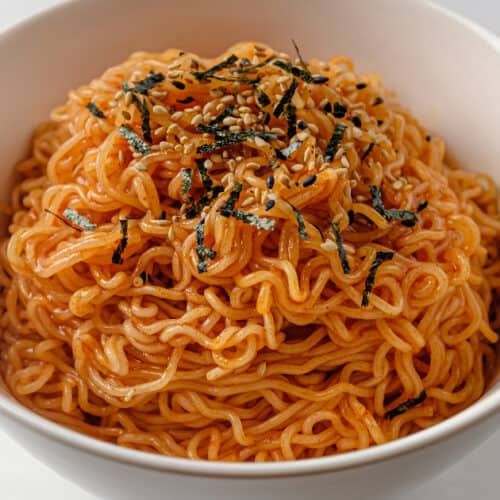Ramen noodle dishes are beloved comfort foods enjoyed all over the world. The classic ramen consists of wheat noodles served in a flavorful broth with meat and vegetables. While the traditional ramen noodle soup hails from Japan, Koreans have put their own spin on this popular noodle bowl. Gochujang ramen infuses the dish with the sweet, spicy, umami flavors of Korea.

Gochujang is a Korean fermented chili paste that forms the base of many Korean dishes. Along with glutinous rice powder, fermented soybean powder, salt, and red chili pepper, gochujang lends a rich, savory depth to foods. Mixed into a ramen broth, gochujang transforms plain noodles into an addictive, complex flavor experience. Toppings like eggs, meat, and vegetables add even more interest to this hearty one-bowl meal.
Gochujang Ramen Ingredients
While gochujang stars in this ramen recipe, several other ingredients work together to build an incredible broth. Here's what you'll need:
- Gochujang paste - The fermented chili paste that gives the dish its signature Korean flavor. Use mild or spicy gochujang depending on your heat preference.
- Chicken or vegetable broth - The broth forms the base of the soup. Chicken broth offers an umami richness, while vegetable broth makes a lighter soup.
- Soy sauce or tamari - Salty soy sauce boosts the savory flavors. For a gluten-free option, use tamari instead.
- Sesame oil - Just a touch of sesame oil provides a nutty aroma. Toasted sesame oil tastes best.
- Rice vinegar - The mild acidity of rice vinegar provides balance.
- Garlic - Minced or grated garlic adds a punch of flavor. Adjust the amount to your taste.
- Ginger - Grated ginger root gives the broth a fresh bite. It's optional but highly recommended.
- Green onion - Thinly sliced green onions garnish the finished ramen with color and texture.
- Ramen noodles - Fresh or dried ramen noodles work well. Check labels for gluten-free options.
- Protein - Shredded rotisserie chicken, pork, beef, or tofu gives this ramen a hearty substance.
- Vegetables - Mushrooms, cabbage, leafy greens, broccoli, and more make tasty toppings.
- Eggs - Half a soft-boiled egg or marinated ramen egg finishes the bowl beautifully.
With a few basic Asian pantry items, you can whip up a pot of flavorful gochujang ramen in 30 minutes or less. The ingredient combinations bring immense complex flavor to a simple noodle soup.
Step-By-Step Instructions for Making Gochujang Ramen
Follow these easy steps to make hearty, spicy gochujang ramen at home:
Prep the aromatics
- Peel and finely grate the garlic and ginger. Thinly slice the green onions at an angle.
- If using, cut the protein and vegetables into bite-sized pieces.
- Cook eggs if making ramen eggs.
Make the gochujang broth
- Combine the gochujang paste, soy sauce or tamari, sesame oil, rice vinegar, garlic, and grated ginger in a medium pot.
- Add the broth and bring to a boil over high heat. Reduce the heat and let simmer.
Cook the noodles
- Once the broth simmers, add the ramen noodles. Cook according to package directions.
- For extra starchiness, cook noodles right in the broth. For a clearer broth, boil noodles separately.
Finish and serve
- Divide noodles between serving bowls. Top with protein, vegetables, and eggs.
- Garnish with green onions and sesame seeds. Serve immediately.
With a well-stocked pantry, this easy ramen comes together in under 30 minutes. The fermented gochujang transforms basic ingredients into a complex, addictive dish.
Tips for Customizing Your Gochujang Ramen
One of the best things about ramen is how customizable it is. You can tweak a basic gochujang ramen recipe to suit your tastes and what you have on hand.
Adjust the spice level - If you're spice-sensitive, use less gochujang and omit the chili garlic oil. For extra heat, add red pepper flakes or more gochujang.
Swap the noodles - Rice noodles, udon noodles, soba noodles, and pasta all work deliciously. Check labels for gluten-free options.
Switch up proteins - Chicken, pork, beef, turkey, shrimp, tofu - take your pick of proteins to sprinkle on your customized ramen.
Load up on toppings - Get creative with quick-cooking or pre-cooked vegetables like mushrooms, broccoli, cabbage, carrots, leafy greens, and more.
Season to taste - At serving, adjust the saltiness with soy sauce or salt and acidity with rice vinegar or lime juice.
Garnish with extras - Ramen eggs, chili oil, sesame seeds, hot sauce, and microgreens add extra flavor and crunch.
The basic gochujang ramen recipe serves as a springboard for crafting your perfect spicy Korean noodle soup.
Gochujang Ramen Variations
Once you master the easy homemade gochujang ramen recipe, try these tempting variations for new flavor adventures:
Smoky Kimchi Ramen
- Add a spoonful of pureed kimchi and a dash of liquid smoke to the gochujang broth.
- Top with sautéed shiitake mushrooms, spinach, and extra kimchi.
Coconut Curry Gochujang Ramen
- Swap coconut milk for half the broth and add red or green curry paste to the gochujang sauce.
- Top with sautéed veggies and crispy baked tofu.
Bulgogi Beef Gochujang Ramen
- Use bulgogi marinated shredded beef as the protein.
- Quick-pickle thinly sliced carrots and cucumber while the broth simmers.
Thai-Style Gochujang Ramen
- Season the broth with lime juice and lemongrass.
- Use rice noodles and garnish with chopped peanuts, cilantro, and lime wedges.
Creamy Miso-Gochujang Ramen
- Whisk in white or yellow miso paste for a luxuriously rich broth.
- Finish with sweet corn, shredded pork, and ramen egg.
The fermented chili umami of gochujang ramen adapts beautifully to creative flavors. Let your imagination run wild!
Gochujang Ramen Tips and FAQs
Where can I find gochujang?
Most major grocery stores stock gochujang paste in the Asian foods section. Otherwise, visit an Asian specialty market or purchase it online.
Is gochujang ramen spicy?
It depends on the amount and type of gochujang used. For mild spice, use less gochujang or a milder brand. For extra heat, add more gochujang or red pepper flakes.
Can I make gochujang ramen gluten-free?
Yes! Use tamari instead of soy sauce, swap rice noodles for ramen noodles, and ensure gluten-free status for the gochujang.
How do I store leftover gochujang ramen?
Transfer broth to an airtight container and noodles/toppings to a separate container. Refrigerate both for up to 3 days.
Can I freeze gochujang ramen? Yes, the broth freezes well for 1-2 months. Cook noodles separately when reheating.
Conclusion
From its short ingredient list to endless adaptability, gochujang ramen makes for a quick, hearty meal bursting with complex flavors. The sweet, nutty, spicy gochujang pairs beautifully with savory broth, satisfying noodles and toppings. In 30 minutes, you can recreate this popular Korean restaurant dish at home. Put your own creative spin on gochujang ramen for a customized noodle bowl the whole family will love.

Gochujang Ramen
Ingredients
- 3 tablespoons gochujang paste
- 2 cloves garlic, minced
- 1 tablespoon grated fresh ginger
- 3 cups chicken or vegetable broth
- 2 tablespoons soy sauce or tamari
- 1 tablespoon toasted sesame oil
- 1 tablespoon rice vinegar
- 8 oz fresh or dried ramen noodles
- Protein (shredded chicken, pork, or tofu)
- Vegetables (mushrooms, spinach, etc.)
- Toppings like green onions, sesame seeds, soft boiled egg
Instructions
- In a medium pot, combine gochujang paste, garlic, ginger, broth, soy sauce, sesame oil, and rice vinegar. Bring to a boil.
- Add noodles and cook according to package directions until tender.
- Add protein and vegetables, cooking for 1-2 minutes until heated through.
- Divide noodles and broth between bowls. Top with desired garnishes.
- Serve immediately and enjoy!

